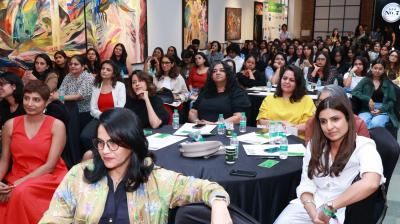From Boomers and Gen Xers swearing by the sanctity of traditions, to millennials who rebelled against the trifecta of ‘parampara, pratishtha, anushashan,’ to Gen Z returning to a new avatar of traditions - brands are presented with new challenges to stay relevant in culture.
The idea of tradition has always been bigger than just rituals or habits. For Gen Z, it is proving to be not only an experience that is new yet rooted in the familiar, but also an antidote for loneliness and loss of community, as a way to belong to something bigger than themselves, and the world they recognise virtually. However, they are refusing to inherit traditions just as they are presented to them, but actively re-interpreting them in a way that fits in with their evolved values and lifestyles.
From “fake weddings” - complete with mehendi, haldi and sangeet - except no couple is getting married, are hosted not to mark a union but to celebrate togetherness, queer love, or simply the joy of dressing up. Or homegrown beauty brands that adopt grandmother-approved skincare rituals but package them in hyper-modern, aesthetic-first forms. Making the brands uber-cool! In this new cultural paradigm, the past is not rejected but re-framed and turned into a canvas for self-expression. Where elements of tradition are cherry-picked for joy and comfort, transforming the very idea of tradition itself.
This shift has important implications for brands - especially ones that draw meaning, authority, and relevance from tradition. For a generation that seeks agency, individuality, and personalised meaning-making, tradition can feel like a constraint unless it evolves to fit their current contexts.
Brands are following through
Some brands have realised this, which has brought them closer to their core business and values, along with those of the audience they wish to cater to.
Take the Masaba bride - a joyful and expressive woman enjoying her moment with abandon. She retains the aesthetic of a wedding, without the trappings of its tradition or its gendered expectations. The spirit of celebration is retained, but the burden of conformity is rejected. Or Licious, taking on the fast-eclipsing tradition of families eating together (given everyone leading steadily isolated lives) by creating a new ritual of ‘Licious Sundays’ - a day reserved for sitting together at the table to share a meal.
This is not limited to communications alone. Product innovations are seen, and brands can take inspiration from others doing this well. CaratLane transformed the mangalsutra into a sleek bracelet. This maintained the emotional and cultural significance of the piece, which symbolises and visualises women being married, but adapted it to a generation that prizes a chic aesthetic, versatility, and subtlety.
All these brands have something crucial in common: being tethered to their core meaning, and yet having evolved to make room for experimentation and new expressions prized by their audience.
Future of traditions: The Big 4 pillars of transformation
For brands steeped in tradition, the future is shifting from being preservers of tradition to collaborators of transformation in a cultural evolution. Four key pillars can guide this shift:
1. Go back to the core, to make more room
Identify the core emotional code of the tradition. Is it comfort, joy, togetherness? Then find new ways to express it that align with Gen Z values. The Licious Sunday meal isn’t about cooking, it’s about togetherness. Being a bride isn’t about coyness or the patriarchal traditions that surround the wedding, but her very personal joy. These make room for new interpretations.
2. Enable co-creation
Gen Z doesn’t just want to be passed tradition down to, but to make it their own. An example of this can be an apparel brand creating fan merchandise for the IPL by encouraging fans to send in their jersey design ideas and voting on design formats. This shifts fandom from passive tradition, i.e. wearing your team’s colours, to active participation.
3. Address shifting social contexts
Reflect on how the social context around your brand has shifted over the years in order to re-examine the traditions it is built around. Take, for example, the importance of preserving the taste, texture and flavour of traditional recipes. One of the biggest truths for millennials and even Gen Zs in India is the relocation (which, according to the MTV Youth case study, they dislike) they need to do to other cities for opportunities. Who then continues to cook the food, keeping those tastes intact? It isn’t about the legacy of the recipes, but the familiarity, love and a sense of anchorage that the taste of that food represents. Traditionally, as well as in brand communication, the representation of the cooking has been done by the woman of the house- the mummy/the bahu- her relationship being her only identity. However, with women questioning the set gender roles and altering ideas of families, brands that operate in traditional tastes and authenticity could reframe their stories on who carries which authentic flavours forward in the changing realities.
4. Express through aesthetics, flaunting value and convenience
The new traditions must provide all three, and must fit into the grid of Gen Z schedules and their Instagram. Take the mangalsutra bracelet - a format that seamlessly fits into a modern woman’s everyday wear. These traditions cannot be hindrances to a busy life but packaged in ways that make them palatable, accessible and enjoyable.
The new cultural zeitgeist: Imagining the future of tradition-focused categories and brands
Spices, for example. How can they evolve for a young Indian who cooks occasionally and lives alone? What does the idea of tradition and authentic tastes now mean to such audiences? Will the recipes now available online through these brands read ‘for one’ or ‘two’? Can there be pre-mixed packs that promise the same taste? Or easier ways to get the same results? What role can packaging play? How can the aesthetics be altered? In doing these, the core of authentic tastes being made accessible only gets extended to accommodate these new realities. The same must also reflect in how the brands communicate, to make them even more relatable.
Another example can be Chyawanprash as a category - a spoonful of immunity-boosting paste that has traditionally been fed by a parent to their child, the emotional coding being a natural way to care for health (for someone you love). Taking the same core of ‘health care, naturally, ’ and setting it in a new context of care for oneself could help extend and create a new habit. Can the aesthetic and access of Chyawanprash also be extended? To gummies that can be popped in as recommended on the go, packed in visually pleasing formats for the self-care range?
To continue to stay relevant in culture, tradition too needs to now be seen as dynamic and evolving, much like culture itself. It needs to have room to be interpreted, co-created with and brands that replay or create tradition are perfectly positioned to leverage Gen Z’s gravitation towards tradition and their need to alter them before embracing them. This opens a new, exciting world for brands to innovate, collaborate and communicate.
The author is strategist, Virtue India.










